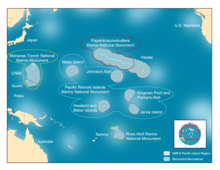Pacific Remote Islands Marine National Monument
The Pacific Remote Islands Marine National Monument is an American national monument west and south of Hawaii . It is located in a so-called "non-incorporated territory" of the United States , which is assigned to the United States Minor Outlying Islands for statistical purposes . The Pacific Remote Islands Marine National Monument was designated by President George W. Bush on January 6, 2009 by a Presidential Proclamation with an area of 86.888 km². Care is provided by the United States Fish and Wildlife Service (USFWS) and the National Oceanic and Atmospheric Administration . On September 25, 2014, President Barack Obama issued another Presidential Proclamation to enlarge it to an area of 313,818,892 acres (1,269,980 km²). The sanctuary includes the islands and atolls of Kingman , Palmyra Atoll , Howland Island , Baker Island , Jarvis Island , Johnston Atoll and Wake with surrounding water bodies. Most of the islands and parts of the waters were designated as National Wildlife Refuge even before they were designated as Marine National Monument .
nature
In the Pacific Remote Islands Marine National Monument there are trees, grasses and birds that are unique to the world. There are large seabird breeding colonies on the islands. Sea turtles , whales, Hawaiian monk seals, and other marine life are found in the waters. There are large coral reefs in the reserve. Commercial fishing and other resource extraction activities such as deep-sea mining are prohibited throughout the Pacific Remote Islands Marine National Monument . In Marine National Monument just research, free passage, and recreation is permitted.
People
The islands have no indigenous people. There are five biologists on Johnston Atoll. In 2000 there were 1,100 soldiers and civilian employees of construction companies there. The US military withdrew in 2007. The Johnston Atoll was used as a rocket launch site from 1958 to 1975 . Rockets for high-atmospheric tests of hydrogen bombs were also launched from the atoll . This is where Operation Hardtack and Operation Starfish Prime came about . In the atoll, Sand Island and Johnston Island were contaminated by fallout from rockets that exploded unexpectedly. After aboveground nuclear weapons tests were banned, numerous research rockets were launched from Johnston Island until 1975 . From 1971 on, Johnston Island also served as a warehouse for chemical warfare agents such as sarin and Agent Orange . In the late 1980s, a facility, the Johnston Atoll Chemical Agent Disposal System (JACADS) , was built on the island for the incineration of chemical warfare agents. In the early 1990s, for example , chemical weapons previously stored in the Palatinate were destroyed here in the course of the Lindwurm campaign . After the chemical warfare agents had been burned, the facility was dismantled again in 2003.
Wake currently has a population of approximately 125 soldiers and military contractors. Japan captured the island at the Battle of Wake in December 1941 and held it until the end of the war. Wake has been used by the US Air Force since 1945 . Wake and Johnston Atoll are still administratively managed by the US Air Force today.
On the Palmyra Atoll there are four to twenty employees from the US Fish and Wildlife Service and conservationists. The other four islands are usually uninhabited.
Public access to the islands is through a special permit from the US Fish and Wildlife Service and is generally restricted to scientists. Aircraft runways are intact on Wake, Palmyra Atoll and Johnston Atoll, while previous military runways on Howland Island, Baker Island and Jarvis Island have been abandoned and are no longer operational.
Possible area reduction by President Trump
On April 26, 2017, President Trump, with Executive Order 13792, instructed the United States Department of the Interior to review the area of 27 National Monuments, which were designated after January 1, 1996 and are at least 100,000 hectares in size. On August 24, Home Secretary Ryan Zinke presented the final report on Executive Order 13792 . The final report called for land reductions in the Bears Ears National Monument , Cascade-Siskiyou National Monument , Gold Butte National Monument , Grand Staircase-Escalante National Monument , Pacific Remote Islands Marine National Monument and Rose Atoll Marine National Monument . In addition, more traditional human uses such as grazing, logging, coal mining and commercial fishing are to be allowed within the protected areas for all National Monuments examined. Zinke justified this by saying that presidents had gone too far in recent decades to restrict commercial activities in the National Monuments.
photos
Great Frigate Bird Palmyra Atoll
Pallet Doctorfish Baker Island
Web links
- United States Fish and Wildlife Service : Pacific Remote Islands (official site)
- Photos from the United States Fish and Wildlife Service's Pacific Remote Islands Marine National Monument on Flickr
Individual evidence
- ^ Establishment of the Pacific Remote Islands Marine National Monument
- ↑ Obama proposes vast expansion of Pacific Ocean marine sanctuary Washington Post June 17, 2014
- ^ Presidential Proclamation --- Pacific Remote Islands Marine National Monument Expansion
- ↑ Johnston Island - List of all rocket launches in the Encyclopedia Astronautica , accessed on June 3, 2017 (English).
- ↑ Keith Schneider: US plan to burn chemical weapons stirs public fear. The New York Times, April 29, 1991, accessed January 21, 2018.
- ↑ Gregg K. Kakesako: Johnston Atoll: The end of an era. Honolulu Star Bulletin, November 6, 2003, accessed January 21, 2018.
- ↑ Executive Order 13792 of April 26, 2017 Review of Designations Under the Antiquities Act
- ↑ Final Report Summarizing findings of the Review of Designations Under the Antiquities Act
- ↑ Shrink at least 4 national monuments and modify a half-dozen others, Zinke tells Trump Washington Post, September 17, 2017







